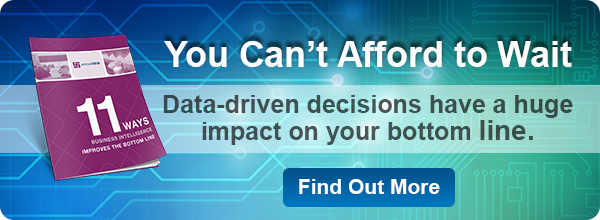Introduction
 In a blog posted a few years ago, we introduced how providers can discover the hidden treasures of data mining. In it we wrote, “Refined data transformed into information becomes knowledge and knowledge – the power to act. Data mining, therefore, helps executives discover what is happening now, track trends, anticipate with some accuracy what may happen in the future, and explore the strengths of possible actions.” The data treasure trove becomes meaningful when viewed through dashboards.
In a blog posted a few years ago, we introduced how providers can discover the hidden treasures of data mining. In it we wrote, “Refined data transformed into information becomes knowledge and knowledge – the power to act. Data mining, therefore, helps executives discover what is happening now, track trends, anticipate with some accuracy what may happen in the future, and explore the strengths of possible actions.” The data treasure trove becomes meaningful when viewed through dashboards.
This concept has direct application to your QAPI[1] initiatives.
What is a dashboard?
A dashboard helps deliver information which is easy to retrieve, interpret, and act on. It may include tables, charts, and graphs indicating progress toward your QA goals and can deliver alerts to Key Performance Indicators (KPIs)[2] which may be significantly below or above targeted benchmarks. Because a dashboard offers information refreshed throughout the day, clinicians should monitor it routinely. Beyond regular viewing of the dashboard, making it and its displayed results an integral part of everyday conversation among clinicians is extremely important.
How to leverage your dashboard
You have worked hard to create a culture of quality and the dashboard can serve as a tremendous tool for acknowledging and rewarding progress and for working with your team to take opportune corrective action when performance falls short. Because the KPIs are timely and relevant, dashboards invite involvement among all the organization’s key QAPI players.
Through its KPI roll-up and drill-down capabilities, a dashboard enables clinicians at all levels within the organization to view KPIs germane to their responsibilities. A corporate clinical executive can view rolled up KPIs summarizing information at a corporate level. They can also drill down to a region, facility, and department level as desired or direct region and/or facility managers to focus on outliers. Because they do not have to create or wait for reports created and submitted by others, clinical managers can focus on what needs to be done now.
Dashboards can help clinicians to:
- Facilitate communication within a team and among teams across the organization
- Organize and render KPIs accessible at all levels
- Track progress and opportunities for improvement
Some dashboards, like PCT’s primeVIEW, offer a hybrid of clinically-oriented KPI views for clinicians taken directly from the clinical applications each provider uses, such as PointClickCare, and partnered predictive analytics, such as PointRight, and resident and family satisfaction trends from Pinnacle Quality Insight. For example, clinicians can track such KPIs as:A Monthly Clinical Summary
- Year-to-Date Clinical Trending
- Re-hospitalization rates
- 5 Star Rating, including facility ratings, deficiencies and fines, quality measures, comparison to local facilities, staff PPD ratings and trending
- Resident and family satisfaction trends
- Staffing KPIs including actual to census-adjusted labor hour PPDs
- And more.
Dashboards can help clinicians to meaningfully:
- Identity gaps and opportunities
- Take action to redirect and support
Data converted to information delivers the knowledge to take positive steps to achieve an organization’s goals. Business intelligence enables purposeful data mining to extract the relevant data and display it in meaningful ways through dashboards. If you have not already seized the opportunity to harness the power of dashboards, we highly encourage you to do so.
______________________________________________________________________________________
[1] From the AHCA/NCAL website we read that ”QAPI is defined by CMS as ‘an initiative that goes beyond the current Quality Assessment and Assurance (QAA) provision, and aims to significantly expand the intensity and scope of current activities in order to not only correct quality deficiencies (quality assurance), but also to put practices in place to monitor all nursing home care and services to continuously improve performance.’
- “Quality Assurance (QA) = the process of meeting quality standards and assuring that care reaches an acceptable level.
- “Performance Improvement (PI) = continuously analyzing your performance and developing systematic efforts to improve it; also known as Quality Improvement.”
[2] KPIs are quantifiable benchmarks used to measure actual performance compared to, in this case, Quality Assurance and Performance Improvement goals.

/Prime-Care-Technologies-Logo.png?width=191&height=55&name=Prime-Care-Technologies-Logo.png)

 In a
In a 